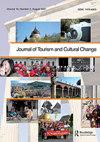“我们的森林——我们的家”:以色列南部贝都因少数民族的休闲和旅游
IF 2.5
4区 管理学
Q2 HOSPITALITY, LEISURE, SPORT & TOURISM
引用次数: 0
摘要
摘要本文考察了以色列南部半干旱沙漠中贝都因少数民族的休闲和国内旅游模式。这项研究是首次使用广泛的定量和定性方法,于2019-2020年在内盖夫-贝都因人中重点关注以色列少数民族在森林中的户外娱乐活动。调查结果表明,在该社区融入犹太多数群体的同时,也存在自我隔离和异化的表现。这项研究证明了森林作为一个“扶持空间”的独特作用,它是中立的,不受内部文化、传统和社会约束。少数群体社会出现了新的内部进程和趋势,但这些进程和趋势尚未显现。其中包括赋予边缘化群体权力,以及在城市定居的贝都因人和生活在农村地区的贝都人之间形成差距。此外,该研究还指出,贝都因社会适应大多数社会的休闲模式的趋势,以及大多数人和少数人在娱乐期间的身体亲密关系。这项研究通过识别和分析特定少数民族群体的趋势和社会进程,有助于对休闲活动进行更广泛的研究。本文章由计算机程序翻译,如有差异,请以英文原文为准。
‘Our forest-our home’: leisure and tourism among the Bedouin minority in southern Israel
ABSTRACT This article examines leisure and in-country tourism patterns of a Bedouin minority population in a semi-arid desert in southern Israel. This study is the first of its kind to focus on an Israeli minority’s outdoor recreational activities in forests using extensive quantitative and qualitative methods conducted among the Negev Bedouins in 2019–2020. The findings indicate that alongside the community’s integration into the Jewish majority, manifestations of self-segregation and alienation were also present. The study demonstrates the forest’s unique role as an ‘enabling space’, neutral and free from internal cultural, traditional, and social constraints. New internal processes and trends were observed in the minority society, which had not yet been revealed. These include the empowerment of marginalised groups and the formation of a gap between Bedouins who settled in cities and those living in rural areas. Moreover, the study points to the trend of adaptation of the Bedouin society to the majority society’s leisure patterns, along with physical closeness between the majority and the minority during recreation. The research contributes to the broader study of leisure activities by identifying and analysing trends and social processes among a particular ethnic minority group.
求助全文
通过发布文献求助,成功后即可免费获取论文全文。
去求助
来源期刊

Journal of Tourism and Cultural Change
HOSPITALITY, LEISURE, SPORT & TOURISM-
CiteScore
5.10
自引率
9.10%
发文量
31
期刊介绍:
Journal of Tourism and Cultural Change ( JTCC ) is a peer-reviewed, transdisciplinary and transnational journal. It focuses on critically examining the relationships, tensions, representations, conflicts and possibilities that exist between tourism/travel and culture/cultures in an increasingly complex global context. JTCC provides a forum for debate against the backdrop of local, regional, national and transnational understandings of identity and difference. Economic restructuring, recognitions of the cultural dimension of biodiversity and sustainable development, contests regarding the positive and negative impact of patterns of tourist behaviour on cultural diversity, and transcultural strivings - all provide an important focus for JTCC . Global capitalism, in its myriad forms engages with multiple ''ways of being'', generating new relationships, re-evaluating existing, and challenging ways of knowing and being. Tourists and the tourism industry continue to find inventive ways to commodify, transform, present/re-present and consume material culture. JTCC seeks to widen and deepen understandings of such changing relationships and stimulate critical debate by: -Adopting a multidisciplinary approach -Encouraging deep and critical approaches to policy and practice -Embracing an inclusive definition of culture -Focusing on the concept, processes and meanings of change -Encouraging trans-national/transcultural perspectives
 求助内容:
求助内容: 应助结果提醒方式:
应助结果提醒方式:


